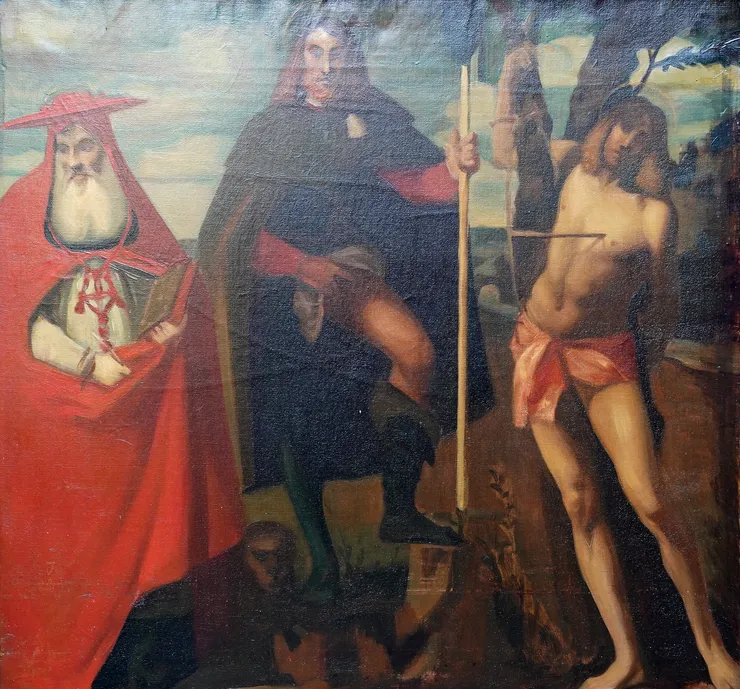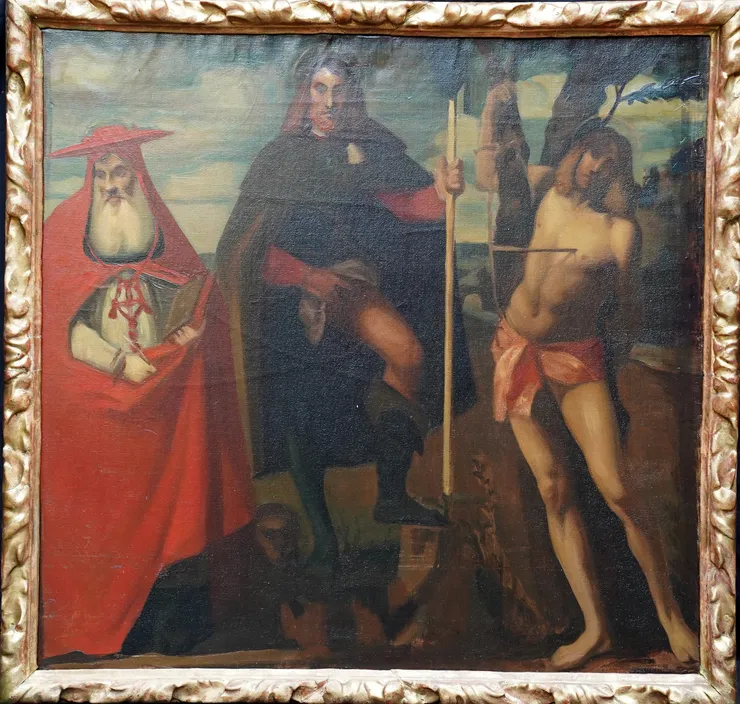| Description |
This superb religious figurative oil painting is by noted artist Wilfred de Glehn. Although some experts rank de Glehn alongside Sargent, he is considered as something of a late British Renoir, for his deft use of sunlight and shadow. Indeed he was good friends with John Singer Sargent and collaborated with his on some projects. This painting, painted circa 1910 is of three saints, from left to right they are Saint Jerome, Saint Roch and Saint Sebastian. It is based on a work attributed to 16th century artist Alessandro Oliverio. Saint Jerome was a biblical translator and monastic leader and is depicted in red, holding books. Saint Roch and Saint Sebastian were known as the Plague saints - Plague saints offered hope and healing before, during, and after times of plague. A specific style of painting, the plague votive, was considered a talisman for warding off the plague. It portrayed a particular saint as an intercessor between God and the person or persons who commissioned the painting – usually a town, government, lay confraternity, or religious order to atone for the "collective guilt" of the community. Rather than a society depressed and resigned to repeated epidemics, these votives represent people taking positive steps to regain control over their environment. Paintings of Roch represent the confidence in which renaissance worshipers sought to access supernatural aid in overcoming the ravages of the plague. The thirteenth-century Saint Roch (or Rocco), whose death is still commemorated in Italy, is especially invoked against the plague. He attended plague victims in public hospitals in Italy according to traditional accounts of his life. Images attributed to the Spanish historical painter Nicolás Borrás in the Royal Cornwall Museum, or other works in institutions from The National Gallery to the Wallace Collection, show him baring his thigh to show the mark of the plague, as he is in this painting. Saint Roch is also the patron saint of dogs, after one carried food to him in the prison where he died. Renaissance images of Saint Sebastian, riddled with arrows in the moment of martyrdom, feature in The Ashmolean and The National Gallery – he was also considered a protection against the plague. Sebastian is said to have served as a Roman soldier in third-century Italy; a Roman prefect whom he converted was supposedly cured of the plague after renouncing pagan beliefs. But it was in the medieval period that healing powers were widely attributed to him. The tree saints are in a landscape with beautiful clouds behind them. This is an interesting example of de Glehn's work and a beautiful depiction of three much loved saints. |
| Biography |
Wilfrid Gabriel de Glehn (sometimes 'Wilfried') RA (1870 – 11 May 1951) was an Impressionist British painter, elected to the Royal Academy in 1932. De Glehn's father was Alexander de Glenn of Sydenham, London, himself the son of Robert von Glehn, a Baltic baron with estates near Tallinn in Estonia, who had become a naturalised British subject following his marriage to a Scottish woman. Wilfrid's mother was French. Louise Creighton, a women's rights activist and author, and Alfred de Glehn, a French steam locomotive designer, were Alexander's sister and brother. Wilfried von Glehn (he changed his name in May 1917) was born in Sydenham, south-east London. After schooling at Brighton College with his brother Louis, he studied art briefly at the Royal Academy Schools in South Kensington before going on to the École des Beaux-Arts in Paris, where for a time he lived with his French cousin, the artist Lucien Monod (1867–1957). In 1891 was hired by Edwin Austin Abbey and John Singer Sargent to assist them on their Boston Public Library mural project at Morgan Hall. De Glehn exhibited his own work first in Rome in 1894 and then in Paris in 1895; he was also elected an Associetaire of the Société des Artistes Français. He first exhibited at the Royal Academy in 1896. De Glehn met American-born artist Jane Erin Emmet (1873–1961) in New Rochelle, New York in 1903, and they were married there the following year. Following their wedding, the couple honeymooned in Cornwall, England, vacationed in Paris and Venice, and made a permanent home in Chelsea, London. However, they travelled extensively, often accompanying Sargent on his trips through Europe. When World War I intervened, husband and wife joined the staff of a British hospital for French soldiers, Hôpital Temporaire d'Arc-en-Barrois, Haute-Marne, France in January 1915. The following year, de Glehn was commissioned and served with the Royal Garrison Artillery. He was seconded to the front in Italy in 1917. In May 1917 his family shed the Germanic 'von Glehn' surname. Because of his fluent French, he spent the last part of the war as an interpreter. After the war, de Glehn held solo exhibitions at the Leicester Galleries and in New York (1920). For the next decade the couple would spend summers in Cornwall and winters in France. Although some experts rank de Glehn alongside Sargent, he is considered as something of a late British Renoir, for his deft use of sunlight and shadow. He died in 1951, at the age of 80, at his home, The Manor House in Stratford Tony, Wiltshire, to which he had moved in 1942 after the Chelsea house had been destroyed in the Blitz. His home was the subject of several paintings, as was the Old Rectory in Wilton, which he had previously rented. His portrait of the cellist Florence Hooton from 1936 hangs in the Duke's Hall, Royal Academy of Music. An oil painting of Venice featured on the BBC's Antiques Roadshow in December 2014 and was valued at £20–30,000. |

